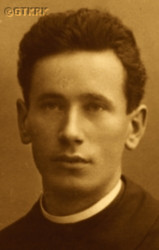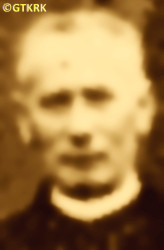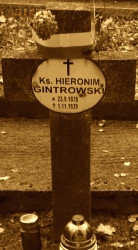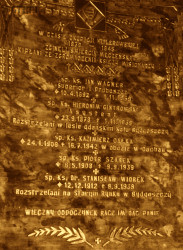Roman Catholic
St Sigismund parish
05-507 Słomczyn
85 Wiślana Str.
Konstancin deanery
Warsaw archdiocese, Poland
full list:
displayClick to display full list

searchClick to search full list by categories
wyświetlKliknij by wyświetlić pełną listę po polsku

szukajKliknij by przeszukać listę wg kategorii po polsku

Martyrology of the clergy — Poland
XX century (1914 – 1989)
personal data
religious status
Servant of God
surname
GINTROWSKI
forename(s)
Jerome (pl. Hieronim)
function
religious cleric
creed
Latin (Roman Catholic) Church RCmore on
en.wikipedia.org
[access: 2014.09.21]
congregation
Congregation of the Mission CMmore on
en.wikipedia.org
[access: 2013.05.19]
(i.e. Vincentians, Lazarists)
date and place
of death
01.11.1939

Gdański foresttoday: part of Bydgoszzcz, Bydgoszcz city pov., Kuyavia‐Pomerania voiv., Poland
more on
en.wikipedia.org
[access: 2021.06.20]
details of death
After the German invasion of Poland on 01.09.1939 (17 days later Poland was attacked by the Russians) and the beginning of World War II, after the start of the German occupation, arrested by the Germans on 15.09.1939, together with his fellow friar priests, Fr Casimir Całka and Fr Eduard Brandys (Congregation's house in Bydgoszcz Germans plundered and seized earlier, on 05.09.1939).
Thrown into the cellars of the Germ. „Internierungslager” (Eng. „Internment camp”), set up in the military barracks in Bydgoszcz.
There met his superior, Fr John Wagner, and Bro.
Luis Muzalewski who had been held there for a week.
Abused, repeatedly interrogated.
Finally dragged out, together with Fr Wagner, tied up and lying face down on the platform of a lorry truck, taken out of the barracks.
The car returned after 20 minutes — empty.
The body was found on 22.09.1947 in a forest near Bydgoszcz — was murdered with a shot to the back of the head.
cause of death
mass murder
perpetrators
Germans
sites and events
Gdański forestClick to display the description, IL BrombergClick to display the description, Pacification of Bydgoszcz 05‐12.09.1939Click to display the description, «Intelligenzaktion»Click to display the description, Reichsgau Danzig‐WestpreußenClick to display the description, Ribbentrop‐MolotovClick to display the description, Pius XI's encyclicalsClick to display the description
date and place
of birth
23.09.1878

Czempińtoday: Czempiń gm., Kościan pov., Greater Poland voiv., Poland
more on
en.wikipedia.org
[access: 2021.07.25]
parents
GINTROWSKI Victor
🞲 ?, ? — 🕆 ?, ?

MICHALEWICZ Agnes
🞲 ?, ? — 🕆 ?, ?
religious vows
28.10.1900 (temporary)
presbyter (holy orders)
ordination
21.06.1906

Krakówtoday: Kraków city pov., Lesser Poland voiv., Poland
more on
en.wikipedia.org
[access: 2021.06.07]
positions held
1934 – 1939
priest — BydgoszczBielawy neighborhood
today: Bydgoszcz city pov., Kuyavia‐Pomerania voiv., Poland
more on
en.wikipedia.org
[access: 2021.06.20] ⋄ Congregation's house, Vincentians CM ⋄ St Vincent de Paul RC parish ⋄ Bydgoszcz‐citydeanery name
today: Bydgoszcz city pov., Kuyavia‐Pomerania voiv., Poland
more on
en.wikipedia.org
[access: 2021.06.20] RC deanery
1927 – 1934
chaplain — Krakówtoday: Kraków city pov., Lesser Poland voiv., Poland
more on
en.wikipedia.org
[access: 2021.06.07] ⋄ St Lazarus Hospital, Vincentians CM ⋄ Immaculate Conception of the Blessed Virgin Mary RC church
1926 – 1927
priest — Bilyi Kamintoday: Zolochiv urban hrom., Zolochiv rai., Lviv obl., Ukraine
more on
en.wikipedia.org
[access: 2022.09.31] ⋄ Congregation's house, Vincentians CM ⋄ Assumption of the Blessed Virgin Mary RC parish ⋄ Zolochivtoday: Zolochiv urban hrom., Zolochiv rai., Lviv obl., Ukraine
more on
en.wikipedia.org
[access: 2021.12.19] RC deanery
1924 – 1926
chaplain — Krakówtoday: Kraków city pov., Lesser Poland voiv., Poland
more on
en.wikipedia.org
[access: 2021.06.07] ⋄ St Lazarus Hospital, Vincentians CM ⋄ Immaculate Conception of the Blessed Virgin Mary RC church
1918 – 1924
vicar — Tarnówtoday: Tarnów city pov., Lesser Poland voiv., Poland
more on
en.wikipedia.org
[access: 2021.06.07] ⋄ Vincentians CM ⋄ Holy Family RC parish ⋄ Tarnów citydeanery name
today: Tarnów pov., Lesser Poland voiv., Poland RC deanery
1912 – 1918
chaplain — Krakówtoday: Kraków city pov., Lesser Poland voiv., Poland
more on
en.wikipedia.org
[access: 2021.06.07] ⋄ St Lazarus Hospital, Vincentians CM ⋄ Immaculate Conception of the Blessed Virgin Mary RC church
1906 – c. 1911
prefect — KrakówStradom, part of Stare Miasto I District
form.: village
today: Kraków city pov., Lesser Poland voiv., Poland
more on
en.wikipedia.org
[access: 2021.06.07] ⋄ Private Philosphy and Theology Study /till 1901 at 17‐19 St Philip Str. (Kleparz), from 1901 at 4 Stradomska Str. (Stradom)/, Vincentians CM ⋄ St Paul the Apostle RC church — also: province's archivist
till 1906
student — Krakówtoday: Kraków city pov., Lesser Poland voiv., Poland
more on
en.wikipedia.org
[access: 2021.06.07] ⋄ Private Philosphy and Theology Study /till 1901 at 17‐19 St Philip Str. (Kleparz), from 1901 at 4 Stradomska Str. (Stradom)/, Vincentians CM
from 25.10.1898
friar — Vincentians CM
author — popular science articles on the history of the Congregation
renowned beekeeper
others related
in death
WAGNERClick to display biography John Francis, BRANDYSClick to display biography Edward Paul, CAŁKAClick to display biography Casimir Francis, MUZALEWSKIClick to display biography Louis, SZAREKClick to display biography Peter, WIOREKClick to display biography Stanislav
sites and events
descriptions
Gdański forest: Location, near Bydgoszcz, where Germans, during «Intelligenzaktion» — extermination of Polish intelligentsia program — murdered a score of Poles. (more on: pl.wikipedia.orgClick to attempt to display webpage
[access: 2012.11.23])
IL Bromberg: Germ. „Internierungslager” (Eng. „Internment camp”) set up on 05.09.1939 — the day Germans took over Bydgoszcz — in 15 Greater Poland Light Artillery Regiment military barracks at 147 Gdańska Str. in Bydgoszcz. In 09.1939 only c. 3,500 Poles were jailed there. Prisoners were held in f. stables or f. armory building. They were maltreated and tortured. Some were shot on the spot (c. 28 victims in 09.1939). Next they were sent to concentration camps throughout Germany. Some were taken to mass execution sites in nearby forests and murdered. On 01.11.1939 the camp was moved to f. ammunition warehouses in Jachcice town district. The camp was closed in 12.1939. (more on: pl.wikipedia.orgClick to attempt to display webpage
[access: 2015.09.30])
Pacification of Bydgoszcz 05‐12.09.1939: The repressions carried out by German Wehrmacht soldiers and SS Einsatzkommando 1 / IV officers (Einsatzgruppe IV sub‐unit) in order to pacify the city and suppress the alleged „Polish uprising in Bydgoszcz”. On 03‐04.09.1939, during the withdrawal, under the pressure of the German invasion, the Polish army passing through Bydgoszcz was attacked by German saboteurs and ollaborators, citizens of the Polish state. The military reacted. C. 365 people died in the fighting and as a result of shootings — events named by the Germans „Bloody Sunday” (about a quarter were Poles, the rest Germans). On 05.09.1939, the Germans entered Bydgoszcz. Resistance was put up, among others, by members of the Bydgoszcz Civic Guard — e.g. 2 Germans were killed in Szwederów district. After receiving an assurance from the German general that their rights due as regular troops would be respected, they laid down their arms — after which about 40 of them were beaten to death with metal bars by the Germans. Then, on 05‐08.09.1939, in various parts of the city, the Germans murdered, in summary executions, from 200 to 400 people. On 08.09.1939, the local commander of the German army, Wehrmacht, ordered the city to be cleared of „criminal Polish elements”. The Germans surrounded the districts inhabited by Poles, searched the apartments and, if any weapons were found (e.g. sabers, batons, etc.), murdered the owners on the spot — the orders were issued to murder all people who „seemed suspicious in any way”. The rest were sent to an internment camp in Polish military barracks. On 09.09.1939, the first public execution of 20 people was carried out in the Old Market Square. The next day — another 20 were executed there. On 09.09.1939 —five. The first phase of the „cleansing” action ended on c. 11.09.1939 — during which the Germans murdered c. 370 Poles. In the following days and months, mass arrests were made and detainees were sent to concentration camps. Bydgoszcz was to become a German city. (more on: en.wikipedia.orgClick to attempt to display webpage
[access: 2022.09.31])
«Intelligenzaktion»: German: «Intelligenzaktion» (English: „Intelligence Action”) — a German program of extermination of the Polish elite, mainly the intelligentsia and leadership layers, carried out from the beginning of the occupation in w 09.1939 to 04.1940, mainly in territories directly annexed to Germany, but also in the so‐called Germ. Generalgouvernement (Eng. General Governorate), where it was called «AB‐aktion». In the first phase, immediately after the beginning of the German occupation, during military operations carried out by the Germ. Wehrmacht (Eng. Armed Forces) and the genocidal units of the Germ. Einsatzgruppen (Eng. Operational Groups) of the Germ. Sicherheitspolizei (Eng. Security Police), i.e. SiPo, and Germ. Sicherheitsdienst des Reichsführers SS (Eng. Security Service of the Reichsführer SS), i.e. SD, organized by the Germ. Reichssicherheitshauptamt (Eng. Reich Main Security Office), i.e. RSHA, which followed the troops, carried out under the Germ. Unternehmen „Tannenberg” (Eng. Operation „Tannenberg”) — based on the so‐called Germ. Sonderfahndungsliste (Eng. Special Wanted Lists), i.e. proscription lists of Poles considered particularly dangerous to the Third Reich, prepared by the Zentralstelle II/P (Polen) unit of the German RSHA. Later, implemented by the German civilian occupation authorities and the genocidal unit of the Germ. Volksdeutscher Selbstschutz (Eng. Ethnic Germans Self‐Defense), whose members were Germ. Volksdeutsche (Eng. Ethnic Germans), i.e. representatives of the German minority in Poland. According to various sources, these lists, at the beginning of 09.1939, could have contained the details of 61,000—88,000 „dangerous” Poles — although these figures cannot be confirmed. In total, during this genocide, c. 50,000 teachers, Catholic priests, representatives of the landed gentry, freelancers, social and political activists, and retired military personnel were systematically and methodically murdered. Another 50,000 were sent to concentration camps, where only a negligible percentage survived. (more on: en.wikipedia.orgClick to attempt to display webpage
[access: 2014.10.04])
Reichsgau Danzig‐Westpreußen: After the Polish defeat in the 09.1939 campaign, which was the result of the Ribbentrop‐Molotov Pact and constituted the first stage of World War II, and the beginning of German occupation in part of Poland (in the other, eastern part of Poland, the Russian occupation began), the Germans divided the occupied Polish territory into five main regions (and a few smaller). The largest one was transformed into Germ. Generalgouvernement (Eng. General Governorate), intended exclusively for Poles and Jews and constituting part of the so‐called Germ. Großdeutschland (Eng. Greater Germany). Two were added to existing German provinces. From two other separate new provinces were created. Vistula Pomerania region was one of them, incorporated into Germany on 08.10.1939, by decree of the German leader Adolf Hitler (formally came into force on 26.10.1939), and on 02.11.1939 transformed into the Germ. Reichsgau Danzig‐Westpreußen (Eng. Reich District of Gdańsk‐West Prussia) province, in which the law of the German state was to apply. The main axis of the policy of the new province, the territory of which the Germans recognized as the Germ. „Ursprünglich Deutsche” (Eng. „natively German”), despite the fact that 85% of its inhabitants were Poles, was Germ. „Entpolonisierung” (Eng. „Depolonisation”), i.e. forced Germanization. C. 60,000 Poles were murdered in 1939‐1940, as part of the Germ. „Intelligenzaktion”, i.e. extermination of Polish intelligentsia and ruling classes, in c. 432 places of mass executions — including c. 220 Polish Catholic priests. The same number were sent to German concentration camps, from where few returned (over 300 priests were arrested, of whom c. 130 died in concentration camps). C. 124,000‐170,000 were displaced, including c. 90,000 to the Germ. Generalgouvernement. Poles were forced en masse to sign the German nationality list, the Germ. Deutsche Volksliste DVL. Polish children could only learn in German. It was forbidden to use the Polish language during Catholic Holy Masses and during confession. Polish landed estates were confiscated..To further reduce the number of the Polish population, Poles were sent to forced labor deep inside Germany. The remaining Poles were treated as low‐skilled labor, isolated from the Germans and strictly controlled — legally, three or three of them could only meet together, even in their own apartments. Many were conscripted into the German Wehrmacht army. After the end of hostilities of World War II, the overseer of this province, the Germ. Reichsstatthalter (Eng. Reich Governor) and the Germ. Gauleiter (Eng. district head) of the German National Socialist Party, Albert Maria Forster, was executed. (more on: en.wikipedia.orgClick to attempt to display webpage
[access: 2024.06.24])
Ribbentrop‐Molotov: Genocidal Russian‐German alliance pact between Russian leader Joseph Stalin and German leader Adolf Hitler signed on 23.08.1939 in Moscow by respective foreign ministers, Mr. Vyacheslav Molotov for Russia and Joachim von Ribbentrop for Germany. The pact sanctioned and was the direct cause of joint Russian and German invasion of Poland and the outbreak of the World War II in 09.1939. In a political sense, the pact was an attempt to restore the status quo ante before 1914, with one exception, namely the „commercial” exchange of the so‐called „Kingdom of Poland”, which in 1914 was part of the Russian Empire, fore Eastern Galicia (today's western Ukraine), in 1914 belonging to the Austro‐Hungarian Empire. Galicia, including Lviv, was to be taken over by the Russians, the „Kingdom of Poland” — under the name of the General Governorate — Germany. The resultant „war was one of the greatest calamities and dramas of humanity in history, for two atheistic and anti‐Christian ideologies — national and international socialism — rejected God and His fifth Decalogue commandment: Thou shall not kill!” (Abp Stanislav Gądecki, 01.09.2019). The decisions taken — backed up by the betrayal of the formal allies of Poland, France and Germany, which on 12.09.1939, at a joint conference in Abbeville, decided not to provide aid to attacked Poland and not to take military action against Germany (a clear breach of treaty obligations with Poland) — were on 28.09.1939 slightly altered and made more precise when a treaty on „German‐Russian boundaries and friendship” was agreed by the same murderous signatories. One of its findings was establishment of spheres of influence in Central and Eastern Europe and in consequence IV partition of Poland. In one of its secret annexes agreed, that: „the Signatories will not tolerate on its respective territories any Polish propaganda that affects the territory of the other Side. On their respective territories they will suppress all such propaganda and inform each other of the measures taken to accomplish it”. The agreements resulted in a series of meeting between two genocidal organization representing both sides — German Gestapo and Russian NKVD when coordination of efforts to exterminate Polish intelligentsia and Polish leading classes (in Germany called «Intelligenzaktion», in Russia took the form of Katyń massacres) where discussed. Resulted in deaths of hundreds of thousands of Polish intelligentsia, including thousands of priests presented here, and tens of millions of ordinary people,. The results of this Russian‐German pact lasted till 1989 and are still in evidence even today. (more on: en.wikipedia.orgClick to attempt to display webpage
[access: 2015.09.30])
Pius XI's encyclicals: Facing the creation of two totalitarian systems in Europe, which seemed to compete with each other, though there were more similarities than contradictions between them, Pope Pius XI issued in 03.1937 (within 5 days) two encyclicals. In the „Mit brennender Sorge” (Eng. „With Burning Concern”) published on 14.03.1938, condemned the national socialism prevailing in Germany. The Pope wrote: „Whoever, following the old Germanic‐pre‐Christian beliefs, puts various impersonal fate in the place of a personal God, denies the wisdom of God and Providence […], whoever exalts earthly values: race or nation, or state, or state system, representatives of state power or other fundamental values of human society, […] and makes them the highest standard of all values, including religious ones, and idolizes them, this one […] is far from true faith in God and from a worldview corresponding to such faith”. On 19.03.1937, published „Divini Redemptoris” (Eng. „Divine Redeemer”), in which criticized Russian communism, dialectical materialism and the class struggle theory. The Pope wrote: „Communism deprives man of freedom, and therefore the spiritual basis of all life norms. It deprives the human person of all his dignity and any moral support with which he could resist the onslaught of blind passions […] This is the new gospel that Bolshevik and godless communism preaches as a message of salvation and redemption of humanity”… Pius XI demanded that the established human law be subjected to the natural law of God , recommended the implementation of the ideal of a Christian state and society, and called on Catholics to resist. Two years later, National Socialist Germany and Communist Russia came together and started World War II. (more on: www.vatican.vaClick to attempt to display webpage
[access: 2023.05.28], www.vatican.vaClick to attempt to display webpage
[access: 2023.05.28])
sources
personal:
www.meczennicy.pelplin.plClick to attempt to display webpage
[access: 2012.11.23], www.hagiographycircle.comClick to attempt to display webpage
[access: 2012.11.23], www.otk.plClick to attempt to display webpage
[access: 2013.12.27]
bibliographical:
„Catalogue des Maisons et du Personnel de la Congregation de la MissionClick to display source page”
original images:
stvincentimages.cstcis.cti.depaul.edu:8181Click to attempt to display webpage
[access: 2016.08.14], naszaprzeszlosc.plClick to attempt to display webpage
[access: 2019.10.13], metropoliabydgoska.plClick to attempt to display webpage
[access: 2017.11.07], grant.zse.bydgoszcz.plClick to attempt to display webpage
[access: 2014.01.06]
LETTER to CUSTODIAN/ADMINISTRATOR
If you have an Email client on your communicator/computer — such as Mozilla Thunderbird, Windows Mail or Microsoft Outlook, described at WikipediaPatrz:
en.wikipedia.org, among others — try the link below, please:
LETTER to CUSTODIAN/ADMINISTRATORClick and try to call your own Email client
If however you do not run such a client or the above link is not active please send an email to the Custodian/Administrator using your account — in your customary email/correspondence engine — at the following address:

giving the following as the subject:
MARTYROLOGY: GINTROWSKI Jerome
To return to the biography press below:
 Click to return to biography
Click to return to biography











